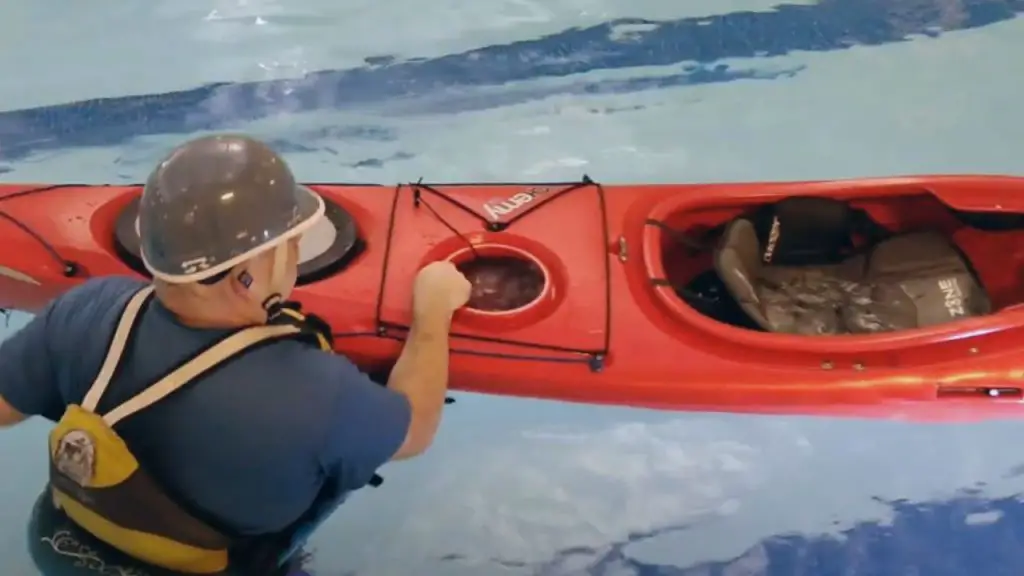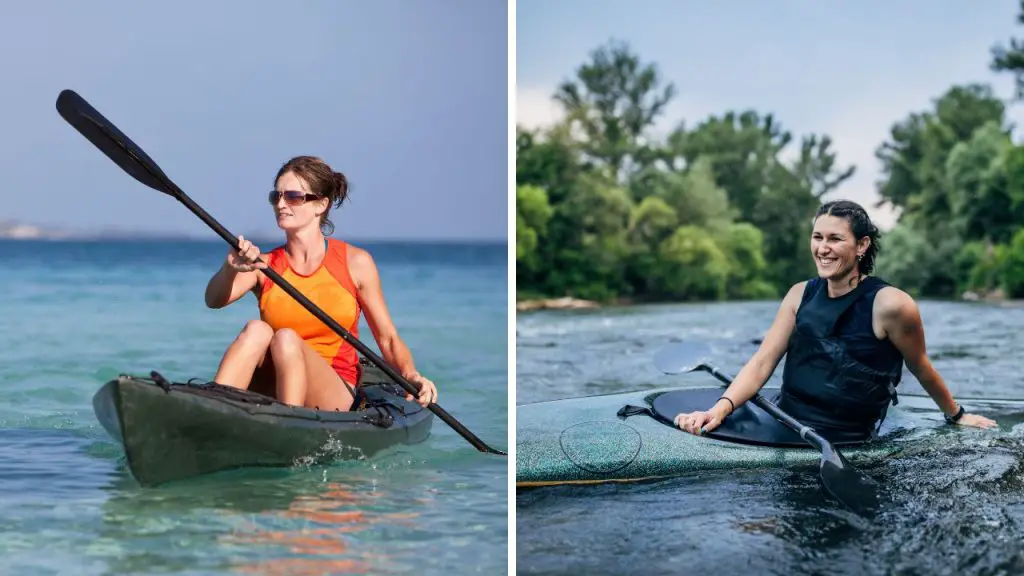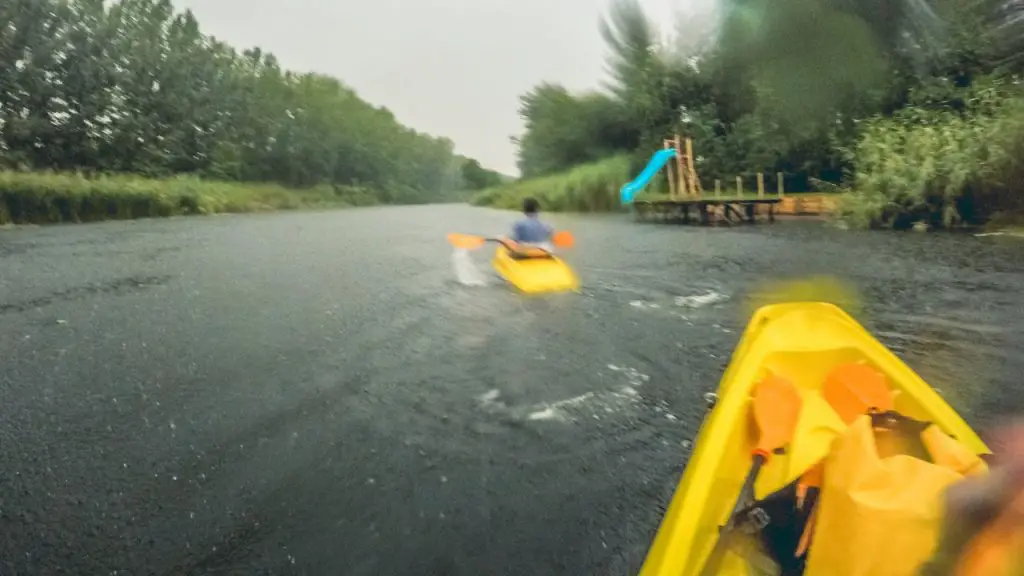Water is a problem in your kayak. How to get water out of a kayak depends on the kayak type. You don’t use the same approach in sit-on kayaks as sit-in ones. The differences in design make it impossible to have a universal procedure for both.
Read on for details about getting water out of any kayak type and tips on keeping your kayak dry.
Table of Contents
Is Water in Kayak a Problem?

Yes. Water is not desirable in a kayak, though sit-on kayaks may be designed by default to have water in them. But if the water level rises, the kayak can become unstable and difficult to control. Some may sink or become very challenging to maneuver.
Water in the kayak will also wet your feet and gear. That is not desirable in any condition and is one of the reasons your boat should remain dry.
But what can make your boat wet? The most possible cause is the rain. That is why you should only go out in the waters on a clear day when precipitation is least expected.
Water may get into your kayak when you are getting in and out. A hole in the hull can also let in water. The kayak can also capsize, which will definitely make it wet. And by design, water can get into the boat through scupper holes.
How To Get Water out of a Kayak
Regardless of what caused water to get into your kayak, you should admit you have a problem at hand and deal with it. Tilting the boat or removing plugs on the scupper holes are the most common ways your boat can get wet. So, you have to deal with water to avoid accumulation that can sink your kayak.

How you get water out of your kayak depends on the kayak type. Let’s explore the best approaches for sit-on kayaks and sit-in kayaks.
For Sit-on-Top Kayak
Getting water out of a kayak begins by assessing the situation at hand. Are you able to paddle to the shore or not?
Most sit-on-top kayaks, if not all, have scupper holes to drain water. That means the water level will not rise to a dangerous level if those holes are not clogged or intentionally blocked by plugs.
The first step is to check all the scupper holes, whether in the water or on shore. Clean any clogged scupper holes or unplug them to allow water to drain out. However, that will not remove all water from your boat.
That is where a hand-operated bilge pump comes in. You should carry it as safety gear to any kayaking adventure. Use it to pump out as much water as possible, and use a sponge to complete the task.
But what if you are at the shore? Water can get into a kayak when you are getting out of it. In that case, pull it out of the water and tip it to drain. You may need to repeat this step many times to get water out. Once the level drops, you can use a lightweight bilge pump and a sponge to suck up the remaining water.
For Sit-in Kayak
A sit-in kayak can get filled with water anywhere. One thing you should note about its design is that the sit-in kayaks do not have scupper holes or holes of any type. Flag it as a problem if you identify a hole in the hull. It may be the reason you have water inside the boat in the first place.
Secondly, the water problem can happen onshore or offshore. Whichever the case, face it with courage. Assess the situation if you are in water and paddle to the shore if you and your kayak are not in danger. Otherwise, try to get water out first.
If you are at the shore, tip the kayak to drain water. That is the best approach because these kayak types do not have scupper holes for draining water. Repeat this process several times until only less water is left inside the boat, and use a sponge to soak it all out.
However, some paddlers create a drainage hole on their sit-in kayaks specifically for this purpose. You can also consider the same if you are in such a situation. But you should block it if you don’t want to drain water from your kayak.
If the water in the kayak is weighing heavily on it and cannot allow you to get to the shore, try to get water out. The best approach is using a hand-operated bilge pump until the level gets down to let you reach the offshore. Learn more on how to get water out of a sit-in kayak.
But if water fills the kayak very fast, consider abandoning it and swimming to safety. It is better to save your life than to go down with the boat!
How To Stay Dry on Your Kayak
Staying dry on your kayak is crucial for a successful trip or fishing activity. Water can be cold, especially in winter, and that can cause health problems. You also want to keep your gear dry for safety. So, how do you achieve that goal?
You can avoid paddling in the rain and capsizing. Raising your seat or plugging the scupper holes can help you to stay dry. Let’s get into the details!
Avoid Going Paddling in the Rain
Paddling in the rain is a ticket to make you wet and allow water into your kayak. Watch the weather and listen to the forecast to know the best days when precipitation is least expected. They are the best days to head into the waters for any kayaking adventure. Avoid going paddling in the rain.

Avoid Capsizing
You will definitely get wet if your boat capsizes. Turning it back up will make the hull and cockpit fill with water. Kayak capsizing is an accident that may not be avoided, but try to reduce your chances.
Consider the weight-carrying limit of your boat and the gears you will carry aboard. Do not exceed or come close to the manufacturer’s specifications. The golden rule is to get up to 70% of the weight limit to avoid capsizing and allow the kayak to be maneuverable.
Getting in or out of Your Kayak from a Dock
Water can get into your kayak when you are getting out of it. That is why we encourage you to use a dry dock or pier to safely get back to land without getting your feet wet. Paddle the boat up to a dry dock and procedurally get out.
Raise Your Seat
This tip applies to those having a sit-on-top kayak. These kayak types have scupper holes that let in water and drain it from time to time. Having a low seat may get your feet wet. So, raising it will make you sit a few inches above the water and remain dry.
Plug the Drainage Holes
Sit-on-top kayaks have holes to drain excess water, preventing the boat from sinking. But brainage holes or scupper holes can also let in water when kayaking, so consider plugging them if you want to stay dry before you get on your kayak.
Universal Kayak Scupper Plugs – Sit On Top Kayak Hole Plugs
Practice Your Paddling Technique
Water can splash back into your kayak, depending on how you paddle it. The boat may also lean to the side, allowing water to get in. Perfecting your paddling technique is a sure way to stay dry when kayaking.
Get a Bilge Pump or Kayak Sponge
As mentioned, your kayak may unavoidably get wet. You should be ready with a bilge pump and/or a sponge for any eventualities. These accessories will help you get water out of your boat and dry it again, whether in the deep waters or at the shore.
Seattle Sports Paddler’s Bilge Hand Pump for Kayaks and Small Boats
Add Drip Rings to Your Paddle
Drip rings added to a paddle stops water from running down the shaft to your hand when paddling. Just place one thermoplastic rubber drip ring at each end of the paddle to stay dry.
Seattle Sports Glow in The Dark Seawall Drip Rings for Kayak Paddles
Wear Waterproof Clothing and an Emergency Kit
Water and weather conditions may change at any time. You may go out into the water thinking it is still and calm. The rain may also be out of the picture. However, everything can change within a blink of an eye. That is when you will remember you have waterproof clothing and an emergency kit to keep you dry.
FROGG TOGGS Men’s Classic All-Sport Waterproof Breathable Rain Suit
FAQs
Why does my kayak have water inside?
By design, a sit-on-top kayak has scupper holes that let in water. But if you have a sit-on kayak, it may be a problem with a hole in the hull. Water can also get into your kayak when getting in or out or when it rains.
Where is the drain plug on a kayak?
Drain holes or scupper holes are typically located at the lowest point of sit-on-top kayaks to allow water to self-drain out of the boat. You will find drain plugs used to block these holes, especially if the kayaker doesn’t want to get wet.
How do you dry out a kayak?
Water can get into your kayak and make everything wet. Getting that water out and drying out your boat is a process. You may need to first tilt the kayak or use a bilge pump to drain water.
The next step would be to sponge the remaining water. But if you want your boat dry, it is better to remove the seat after sponging out water and leave them to dry separately.
How do you drain a kayak hull?
It depends on the kayak type. Drain a sit-on-top kayak by removing the drain plugs or unblocking any clogged scupper hole. For a sit-in kayak, tip it to drain water and use a bilge pump or sponge.
Conclusion
You should remove any water from your kayak as soon as possible. It can sink your boat and reduce stability and maneuverability. Just assess the situation to know if you can safely get to the shore to drain the water or do it while paddling. But try to remain as dry as possible when kayaking using the tips described in this post.
Thank you for reading this article up to the end. Windpaddle appreciates your time and encourages you to explore the website for related content. We also invite you to share this post with fellow paddlers to spread the information.




